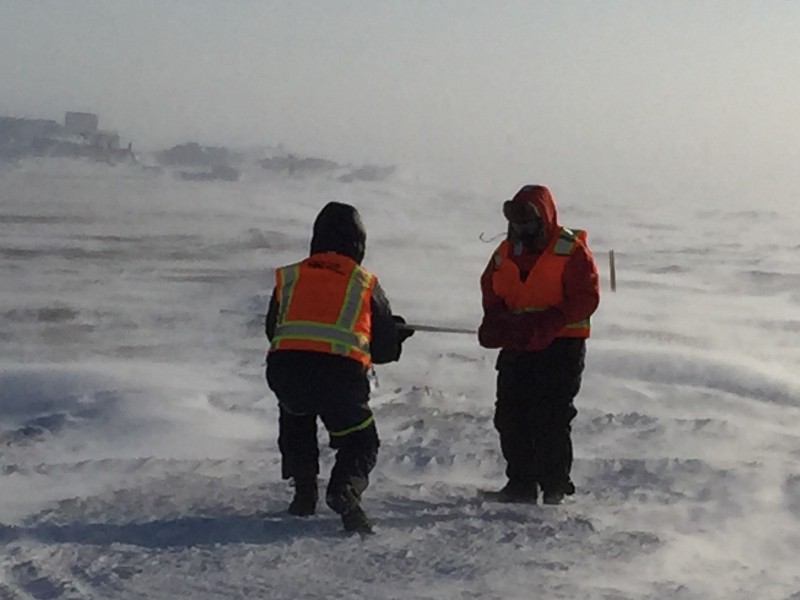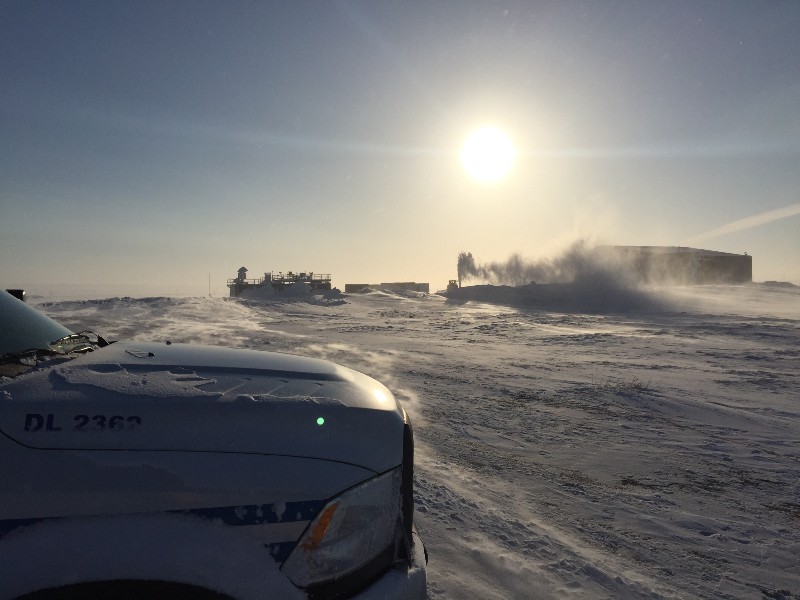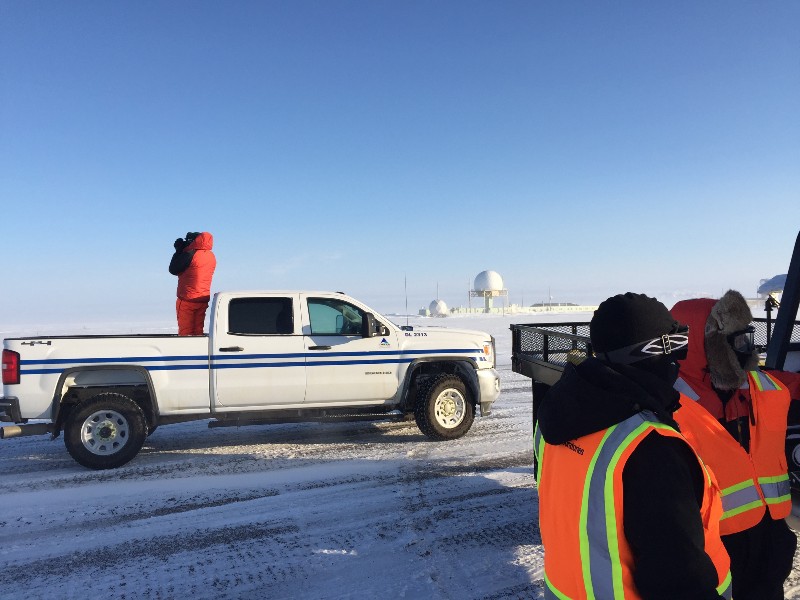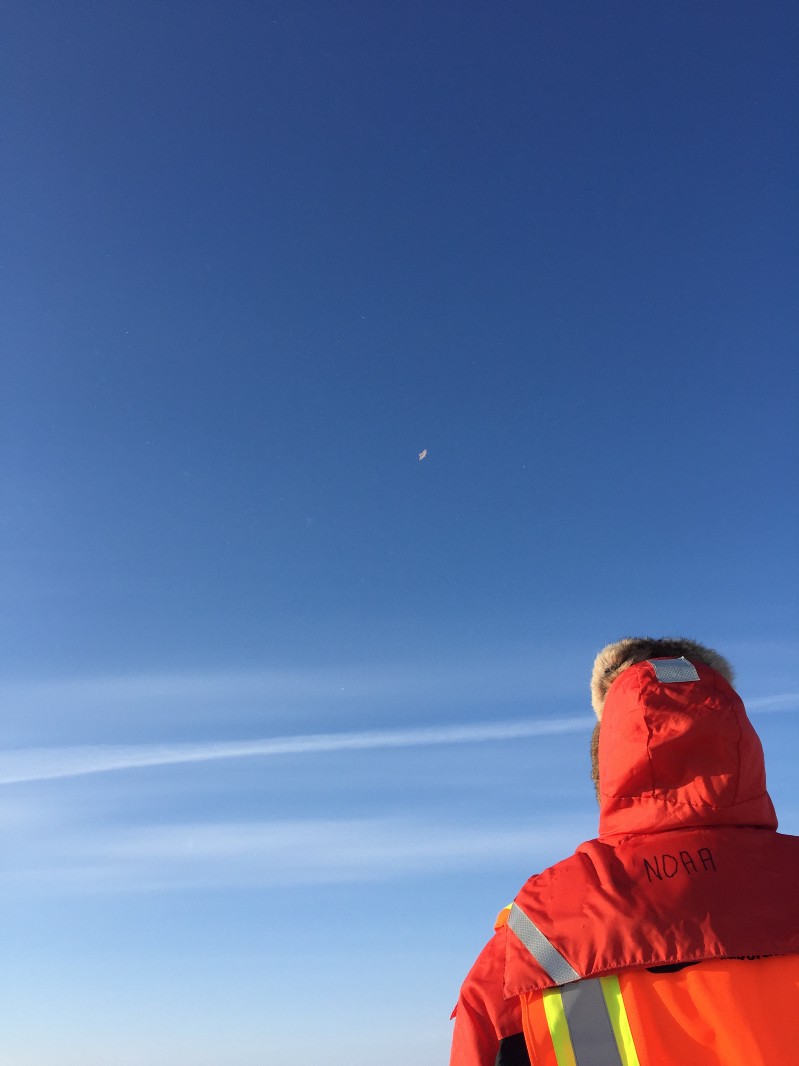
Doug (right) and Gijs (left) prepare to launch a DataHawk 2, in what can only be described as “challenging” conditions.
The weather continues to be nasty up here. This morning at breakfast, the winds looked ever-so-slightly better, so we decided we would put energy into DataHawk flights today, while also continuing to obtain aerosol measurements from POPS on the roof top of the AMF-3.

The AMF-3 and hangar as seen from the runway. The big plume of snow you see is coming from the USAF Caterpillar, outfitted with a gigantic snow-thrower to remove drifts from around the AMF-3.
For those who followed our adventures last summer, you know that we had substantial difficulties flying the DataHawks at Oliktok Point due to interference from the DEW-line radar. At that time, the radar would essentially lock up the central computer that handles everything from the autopilot, to communications to data-logging. Since that time, CU Professor Dale Lawrence, the main developer of the DataHawk, and others have been working very hard to harden the system against such issues. Since it is nearly impossible to recreate the interference in a laboratory setting, the only true way to find out whether things are working is to take the plane back into the field and go fly it! Now if only the winds would cooperate a bit…

Sandia’s Al Bendure (in truck bed) keeps an eye out for bear activity while the team gears up for DataHawk flights. While it looks pretty nice and sunny, the winds were whipping at around 30 mph and snow was drifting pretty substantially!
Nevertheless, we have already made substantial progress in evaluating the updated platform. From our preliminary testing it appears that the impact of the radar is substantially reduced, but has not been entirely eliminated. While the system can now handle the radar and keep itself up and running, we’ve encountered an issue where the radio stops transmitting. In this instance, the plane is still able to fly itself, and the pilot can take manual control of the plane to land it. However, it also will eventually result in what is known as a lost communications (or “lost comm”) situation. Since these planes fly autonomously, they need to know what to do when something goes wrong, and in the case of “lost comm” the plane should return to a predetermined holding pattern. If communications are not re-established within a given amount of time, the plane will terminate flight, meaning that it will initialize a local crash landing. Obviously, this is something to be avoided at all costs, so for the time being, we’re keeping the aircraft close to home.

Doug keeps a watchful eye on the DataHawk flying overhead.
I have to say, it was good to see the aircraft up in the air, albeit for a short time. We are looking to do more of the same tomorrow, although we are very close to the operational limits of this aircraft and things are forecast to get even windier on Sunday and Monday, with winds likely to top 50 mph. Some readers may have noticed the “Roads Normal” or “Phase 1” message that comes along with the wind readout here at the ENI camp. The energy companies have instituted a rating system for the road conditions, where “Normal” means that operations are unlimited, “Phase 1” means that conditions are less than optimal and that vehicles are required to carry Arctic gear with them in case of incident. Beyond this, there is “Phase 2”, where travel is allowed only by convoy, and “Phase 3” where any non-emergency travel is banned. Today, we briefly went to phase 2, and given the forecast it is possible we may hit phase 3 on Sunday evening into Monday. The good news in all of this is that there appears to be a glimmer of hope towards the later part of the forecast, with winds expected to dissipate somewhat (perhaps 15–25 mph) by Wednesday of next week. Tomorrow and Saturday are forecast to be in the 25–40 mph range, and so we’re planning to get out and operate the DataHawks as much as possible. The larger Pilatus will have to wait until conditions calm down a bit more…
